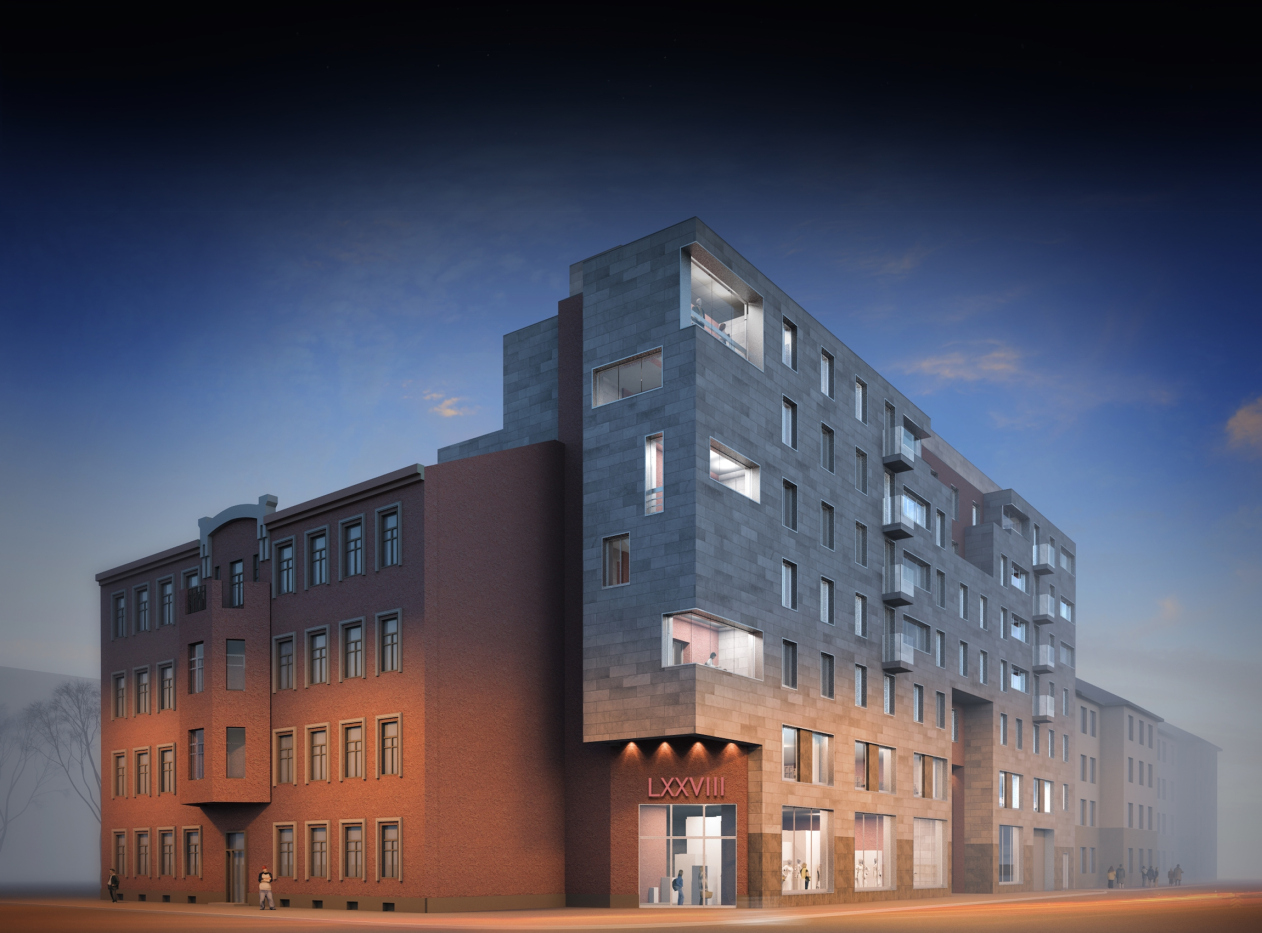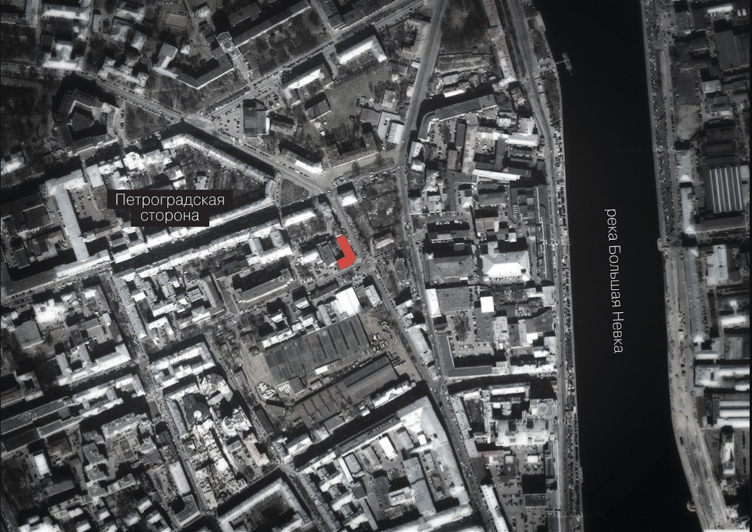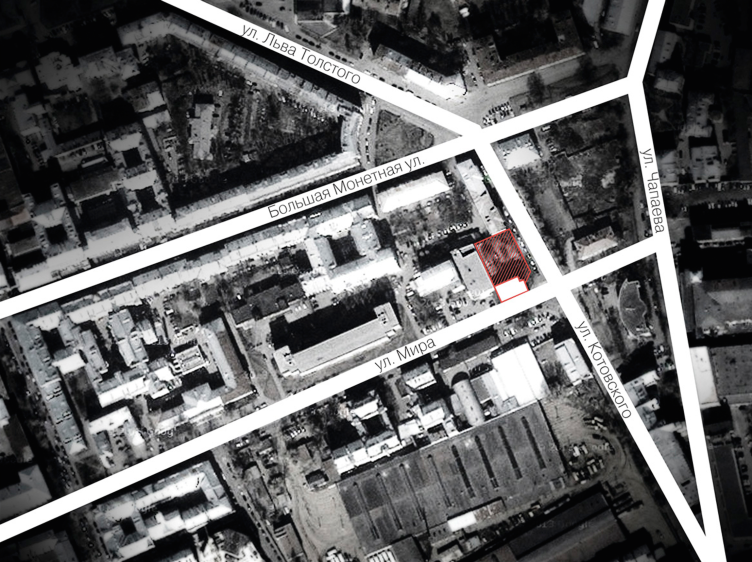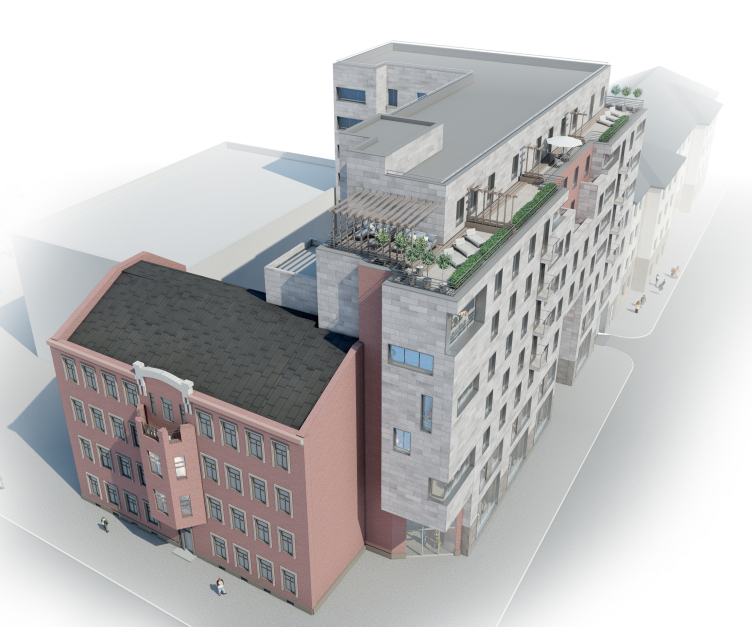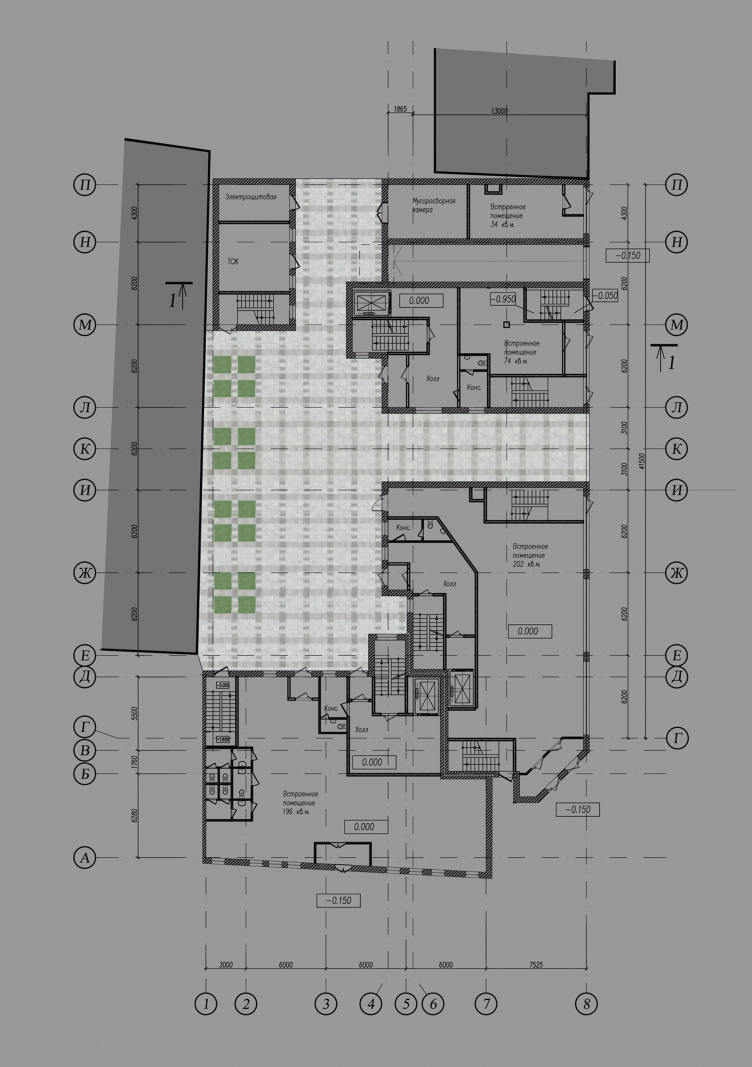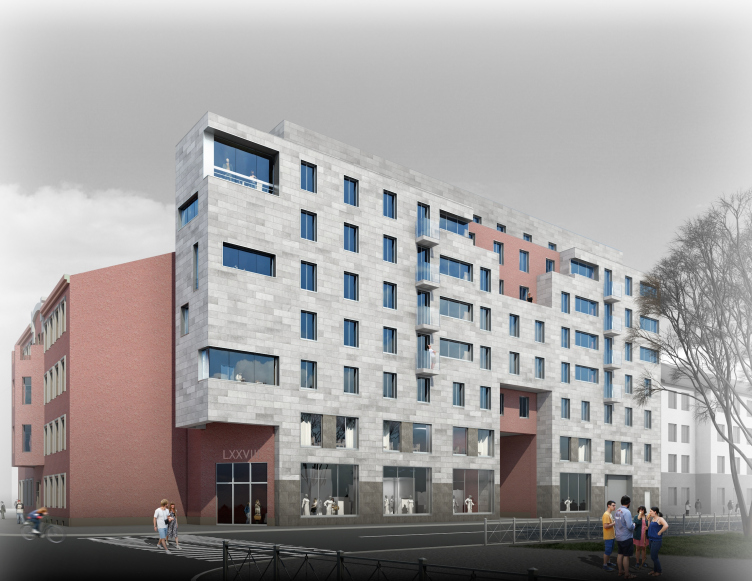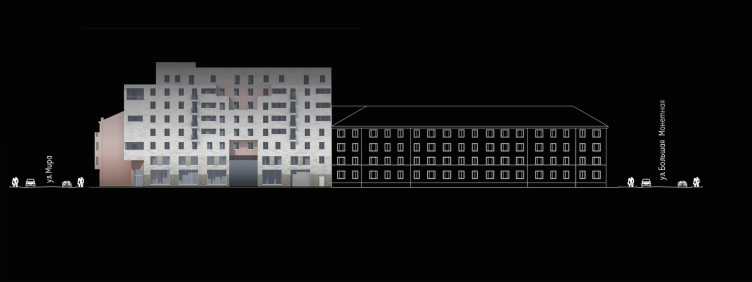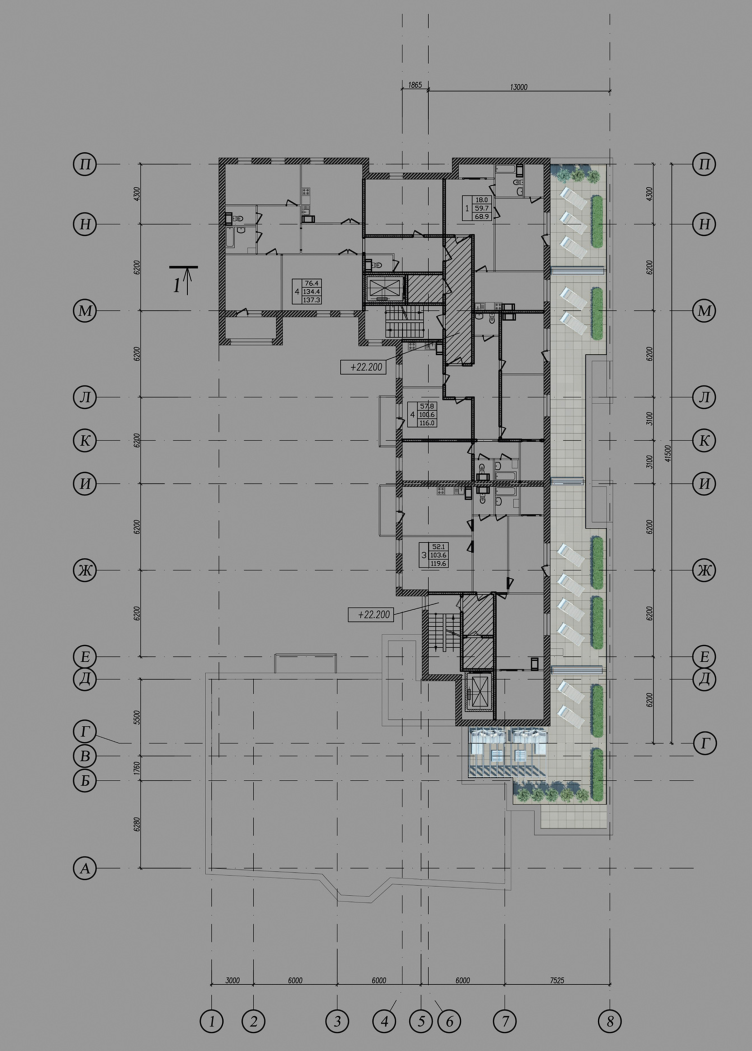The land site in question is located within the industrial park of the Petrograd Side, not far away from the old Tram Depot #3. Running in the vicinity of the Avstriyskaya ("Austrian") Square, the neat and tidy Mira Street turns at this point into something crumbly and incoherent: the remains of what historical buildings are left here neighbor on soviet-era panel "slabs" and structures of a purely utilitarian nature. Recently, such places become increasingly attractive to developers which manifests itself in the growing number of inclusions of modern architecture and even greater quantity of architectural proposals and concepts based upon this idea.
One of such proposals is the project of a residential complex prepared by the studio of Anatoliy Stolyarchuk and due to be implemented at the crossing of Mira and Kotovsky streets. The project had a fair share of hard luck: first of all, it was the necessity of demolishing (and subsequently restoring the facade of) the historical building designed by Dmitry Krzhyzhanovsky. And, although the old tenement was recognized to be a hazard building and all of the people living in it had long since moved into new apartments, the city preservation activists made repeated attempts to challenge in court the municipality's decision about demolishing it. Second of all, finding an understanding with the customer was also far from easy.
Multiapartment building at Mira Street. Project, 2014 © Anatoliy Stolyarchuk Architectural Studio
Multiapartment building at Mira Street. Project, 2014. Location plan © Anatoliy Stolyarchuk Architectural Studio
Multiapartment building at Mira Street. Project, 2014. Location plan © Anatoliy Stolyarchuk Architectural Studio
First about the project itself, though! The authors had a high-responsibility task of "tying in" the new building to the historical one - a humble specimen of Saint Petersburg's tenements with characteristic Art Nouveau features. In town planning terms, the architects were to visually fasten the corner of the crossroads - completely unstructured as yet - and give the amorphous housing a more regular character. The disappearance of the green yard opened up to the Kotovsky Street, will be made up for at the expense of taking down a two-story annex standing in the yard.
The project of Stolyarchuk studio included this recreated historical volume as a part of a balanced composition with an almost symmetrical plan in the shape of giant "double L" stretched hugely apart, this historical volume given the role of one of the risalits. The first floor will perform public functions, just as the two floors of the building along the Kotovsky Street. Higher up, the typical residential floors are situated. At a height of 23 meters, the wall stands out a little: this is where the sightseeing platform for the people living in the loft is situated (the cornice running at a height of 28 meters). Formed by the risalits, the compact yard has two passages in it: along the Mira Street and along the Kotovsky Street.
Multiapartment building at Mira Street. Project, 2014. © Anatoliy Stolyarchuk Architectural Studio
Multiapartment building at Mira Street. Plan of the 1st floor. Project, 2014 © Anatoliy Stolyarchuk Architectural Studio
Multiapartment building at Mira Street. Plan of the typical floor. Project, 2014 © Anatoliy Stolyarchuk Architectural Studio
While the construction plan is to a large extent conditioned by the shape of the land site, the choice of the style for the new building was open and was also the more challenging part because of its Art Nouveau facade. The idea of historical stylization - considering the increase in the scale and considering the overall changes in the composition - was pretty soon discarded by the authors to give way to the modern vocabulary, rather neutral, but still not altogether alien to Krzhizhanovsky's architecture.
The building's main façade that towers three floors above the old cornice, looks at the Kotovsky Street with its austere gray surface dissected by a graphic pattern of punctured lines. The general symmetry of its axial composition is distracted by a protrusion of one of the side walls of the former tenement adjoining the building's firewall. This corner junction of the two side walls got a design solution based upon the contrast of simple geometric volumes, as well as their texture and color, which perfectly matches the key town-planning part that it is meant to play. Through the corner cutaway of its lateral entrance, the theme of the tenement continues over at the main façade. Considering it dimensions, increased in comparison with its historical neighbor, the authors looked to balance out the overall impression with neutral style and light color of the finish. The part of the main accents here is played by the central arch with a modernized lunette and a red-brick figure stanza uniting the two top floors. Their color and axial position match the central bay window in the Krzhizhanovsky's building.
Multiapartment building at Mira Street. Project, 2014 © Anatoliy Stolyarchuk Architectural Studio
Out of the multitude of the existing ways of interacting with the historical context out there, the authors of the project chose the way of, though respectful, equitable and open stylistic dialogue between the modern and the historical. However, it was the style of the building that became the stumbling block in the architects' relationship with the customer, in the result of which the project winning a silver award at "Arkhitekton-2013" was turned down by the customer who then invited a different company to design the project.
This was not how the story ended, however. The "alternative" project fell under hard criticism from the city council: the new designer tried to take the path that Stolyarchuk had originally discarded - meaning, he decorated the new buildings with eclectic "historicism" elements. Ultimately, the customer was forced to turn back to Anatoliy Stolyarchuk for compromise. At the end of the day, Stolyarchuk's studio got the commission for designing the facades and getting them approved in the Committee for City Planning and Architecture and the Committee on State Control, Use and Protection of Historical and Cultural Landmarks.
Multiapartment building at Mira Street. Development drawing along the Kotovsky Street. Project, 2014 © Anatoliy Stolyarchuk Architectural Studio
Multiapartment building at Mira Street. Development drawing along the Mira Street. Project, 2014 © Anatoliy Stolyarchuk Architectural Studio
This story, in spite of its somewhat softened end, is rather sad, and, what's more upsetting, not quite unique. There are lots of cases out there when a customer, upon getting a concept from a renowned company with a long-standing reputation, hands that concept over for further elaboration (or, should we say "fed to the lions", not to put too fine a point on it) to a different company with a task to cut the costs as much as possible. Although in this particular case the situation is a little bit different, it still goes a long way to illustrate just how vulnerable the architect (and, ultimately, the end consumer) is in the face of the overall decline in the demand for high-quality architecture.
The economic crisis did things to the construction schedule but we will hope that the place where once the demolished historical ruin stood will ultimately get a new up-to-date complex keeping the memory of the place and at the same time matching today's standards of what urban environment must be like.
Multiapartment building at Mira Street. Plan of the loft. Project, 2014 © Anatoliy Stolyarchuk Architectural Studio
